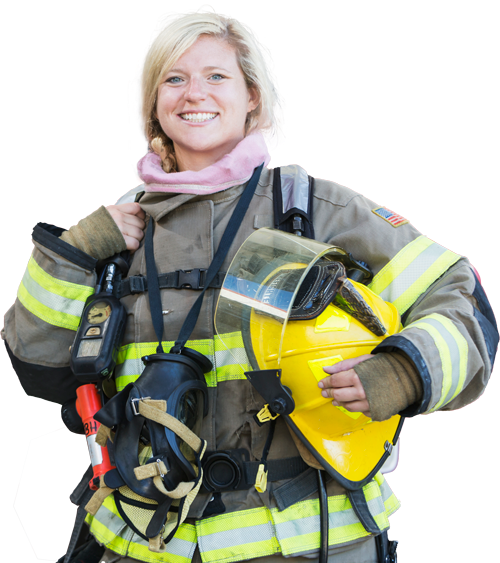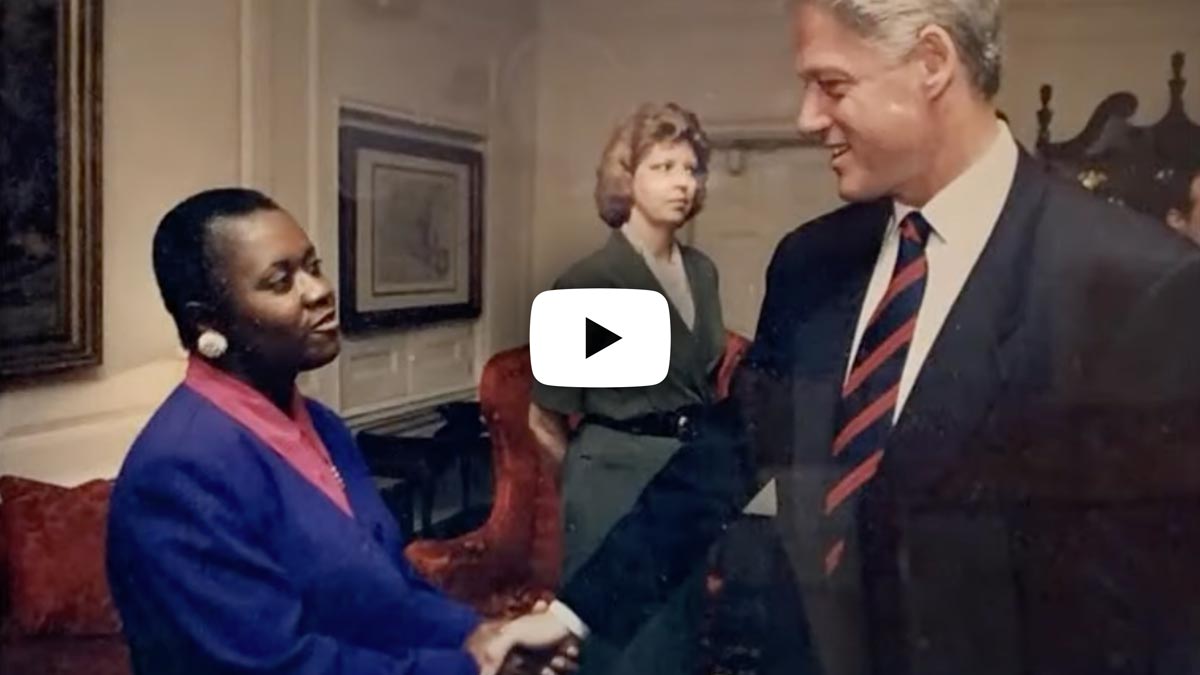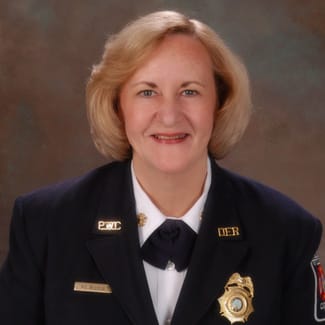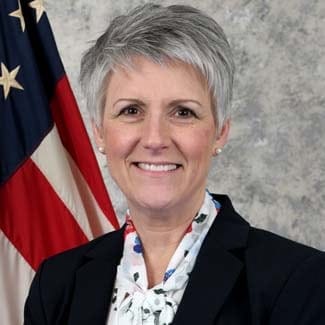Helping fire departments achieve their full potential and serve their communities successfully is something that we at the U.S. Fire Administration (USFA) strive for every day. We firmly believe that a successful fire department needs to have an inclusive and diverse workforce (see our Human Dignity Statement). While we recognize that the fire and emergency medical services (EMS) have made significant strides to improve inclusion and diversity, we still have work left to do.

Fire service leaders: USFA can help you to support women and tackle the unique issues they face on the job.
Women in fire and EMS: Learn about the professional development and teaching opportunities that await you at the National Fire Academy.
9%
of U.S. firefighters are women
- 5% of all career firefighters are women.
- 11% of the volunteer fire service are women.
- 12% of federal wildland firefighters are women.
Sources: National Fire Protection Association, FrontlineWildfire.com
Integrating women into organizations and departments that for generations had been bastions of all-male “homes-away-from-home” has not been easy. Despite more women serving in the fire service in recent years, growth and inclusion of women in the ranks has been extremely slow and lags behind the growth of women in other male-dominated fields.
Why should fire service leaders strive for an inclusive workforce?
Because it is essential for your department to achieve its full potential.
- An inclusive workforce provides diverse life experiences and ideas that can help you craft solutions to long-standing problems.
- With more experiences and different ideas, your department becomes more flexible, proactive and better able to adapt to new challenges.
- When the makeup of your department reflects the makeup of your community, your department can provide a higher level of service because your personnel better understand community needs.
Learn more: What it means to really commit to a diverse and inclusive fire department

https://www.youtube.com/embed/VbgPWbIpHSs
Carrye B. Brown (above) was the first woman and African American appointed as U.S. fire administrator. Current U.S. Fire Administrator Dr. Lori Moore-Merrell became the second woman to serve when she was appointed on Oct. 25, 2021. Video credit: WUSA
The fire department should look like the community it serves. There's nothing that women can't do in the fire service.
Emerging issues for women in the fire service
In 2019, we published “Emerging Health and Safety Issues Among Women in the Fire Service.” This handbook, developed in partnership with Women in Fire, provides an overview of several unique issues that women face in the fire service. It also provides resources for women to help them stay safe and healthy on the job.
Discrimination and harassment
The direct consequences of discrimination and harassment in the fire station can lead to serious mental health and workforce retention issues. In addition, such behavior reflects badly on your department and negatively impacts community support. It can also result in a costly lawsuit against your department or jurisdiction. Instead of using your budget to fund additional personnel or much-needed apparatus and equipment, you could end up wasting it on unacceptable behavior.
I served in fire service for the love of the mission. We must continue to learn and be better, treat everyone with respect and dignity.
Indirect consequences of discrimination may result in health and safety issues related to improper fit of personal protective equipment (PPE) and equipment that is unnecessarily too large or heavy to operate.
Don't wait for an incident to happen before you hold your personnel to a higher standard. If you haven't already, adopt a zero-tolerance policy. Education on discrimination and harassment should be ongoing, not incident driven. PPE needs to properly fit and equipment should be configured for everyone to operate.
Bullying can be reduced by implementing clear workplace rules and policies, offering formal training to all employees on workplace violence and department policies, establishing a formal process for management and resolution of bullying, and implementing a mentoring program.
Recruitment and retention
For the fire service to become gender inclusive, organizational leaders need to examine successful methods to attract and retain women. Women face physical challenges, psychological strains and challenges tied to the long-time male-dominated culture of the fire service. These barriers can adversely affect a department's ability to recruit and retain women.
There have been cases where agility tests were created to intentionally serve as a barrier for women.
Fire service leadership needs to implement evidence-based strategies to combat barriers to the recruitment and retention of women. Suggested strategies include:
- Standardize the Candidate Physical Ability Test.
- Promote inclusivity through training.
- Accommodate the schedules of volunteers to address work-life balance challenges.
- Offer nonwage benefits.
- Recognize employee accomplishments and life moments.
- Develop programs for family engagement.
- Use recruitment methods specific to gender inclusion.
Other issues facing women in the fire service
The handbook also addresses these topics:
- Occupational safety and health.
- Heart health.
- Roadway incidents and emergency vehicle operation.
- Mental health and suicide.
- Firefighter cancer.
To find out how your department can take steps to address them, download “Emerging Health and Safety Issues Among Women in the Fire Service.“
Future opportunities for USFA research on women in firefighting include injuries, cancer, reproductive health and PPE sizing.
Martha Schoppe, Forestry Technician (Smoke Jumper)
Martha is currently the only female smoke jumper with the Department of the Interior. She started her career in wildland fire when she was in her 30s. Martha shares that being a smoke jumper is a challenging career both physically and mentally, and it has a lot of individual responsibility. Parachuting into a fire is very challenging, but she loves it because it gives her a sense of accomplishment.
Smoke jumping is definitely a service job. Knowing that makes the challenges easier. Our service is not only to the forest but also the community. Our relationship with the public is as important as putting out the fire. This is applicable to every emergency service job.
Professional development opportunities through the National Fire Academy
The National Fire Academy (NFA) continues its recruiting efforts to achieve a diverse and inclusive staff, instructor cadre and student body. We encourage women who are interested in advancing their fire and EMS careers to explore our leadership programs for executive fire and managing officers, as well as other classroom and online learning opportunities. Women interested in teaching at the NFA as contract instructors should explore our experience and application requirements.
As NFA Superintendent, I want to strengthen partnerships with other national fire service organizations, such as Women in Fire, that represent the growing diversity of the fire and emergency services.
Our classes range from incident management, leadership, EMS, hazardous materials, wildland urban interface, community risk reduction, fire investigation and many others. We promise that you will learn a lot in the classroom and just as much from your classmates.
The great news is that there is no charge to anyone who wants to attend any of our classes. We even pay for your airfare and lodging if you are selected to attend an on-campus course in Emmitsburg, Maryland.
5 things you can do today to support women in fire and EMS
Select 1 or more of the learning opportunities below to promote professional development opportunities and increase your awareness about health and safety issues that are unique to women firefighters and EMS responders.
- Download and read Emerging Health and Safety Issues Among Women in the Fire Service PDF.
- Encourage women in your department to enroll in NFA training programs and courses, like the Executive Fire Officer and Managing Officer programs, or find other professional development opportunities that suit career and department needs.
- Subscribe to the USFA News and Announcements email list to be notified when our new recruitment and retention handbook is available.
- Increase your awareness about the benefits of organizational inclusion and the unique issues faced by women in the fire service with these resources from the National Emergency Training Center (NETC) Library.
Issues affecting women in the fire service
Investigation of Female Firefighter Fit and Ergonomics in Structural Turnout Suits
Results from this study demonstrate the additional fit issues female firefighters face compared to their male counterparts.
Maternal and Child Health Among Female Firefighters in the U.S.
Miscarriages and rates of pre-term delivery were found to be high among women who became pregnant while working as firefighters.
The Prevalence and Health Impacts of Frequent Work Discrimination and Harassment among Women Firefighters in the US Fire Service
This study evaluates the relationship between chronic work discrimination and/or harassment and women firefighters’ physical and mental health, substance abuse, and job efficacy, stress and satisfaction.
Sisters in the Brotherhood: Experiences and Strategies of Women Wildland Firefighters
Women wildland firefighters experience an array of challenges due to traditional gender norms, gender stereotypes and the culture of dominant masculinity. Strategies they use to deal with those challenges are described.
Inclusion and diversity studies
Calling All Recruits: Departments Are Focusing on Diversity and Inclusion While Navigating Recruitment in a Pandemic
Strategies that some Canadian fire departments are using to recruit women into the fire service.
Diversity and Inclusion Leaders in US Fire Departments Impact the Type and Number of Diversity and Inclusion Programs Offered
This study assesses organizational characteristics of fire departments that employ diversity and inclusion leaders to better understand how they impact firefighter workforce diversity and inclusion.
Diversity, Equity and Inclusion in the Workplace: ‘A Safety Issue’
Stress related to harassment, intimidation, communication difficulties, inadequate training and job insecurity, combined with perceived or actual mistreatment from employers and colleagues, increases worker safety risk.
Females and Minority Racial/Ethnic Groups Remain Underrepresented in Emergency Medical Services: A Ten-Year Assessment, 2008 – 2017
The underrepresentation of females and minority groups observed during this investigation of emergency medical technicians and paramedics suggests that EMS workforce diversity is unlikely to undergo substantial change in the near future.
- Learn more about women who made the fire service their career. Below are 4 profiles to explore.

Kimberly Cox
Captain,
Eden Prairie (Minnesota) Fire Department and Executive Director,
Women in Fire

Amy Hanifan
Operations Chief,
McMinnville (Oregon) Fire Department and President,
Women in Fire

Mary Beth Michos
Senior Advisor,
International Association of Fire Chiefs

Tonya Hoover
Deputy U.S. Fire Administrator,
U.S. Fire Administration

The USFA commitment to fire departments and women in the fire service
We strive to work every day to promote gender inclusivity in the fire service. We support the fire and EMS in keeping women safe and healthy on the job. We support women getting the leadership training they need to advance their fire service careers.
Recommended reading on women in fire and EMS
- Selected readings on women. NETC Library.
- Hemostatic Responses to Multiple Bouts of Firefighting Activity: Female vs. Male Differences in a High Demand, High Performance Occupation. International Journal of Environmental Research and Public Health.
- Drawn to Flame: Women Forged by Wildfire. National Forest Foundation.
- Guide for Creating a Diverse and Inclusive Department. International Association of Fire Chiefs.
- Ladders and Lifting: How Gender Affects Safety Behaviors in the Fire Service. Journal of Workplace Behavioral Health.
- Making U.S. Fire Departments More Diverse and Inclusive. Harvard Business Review.


